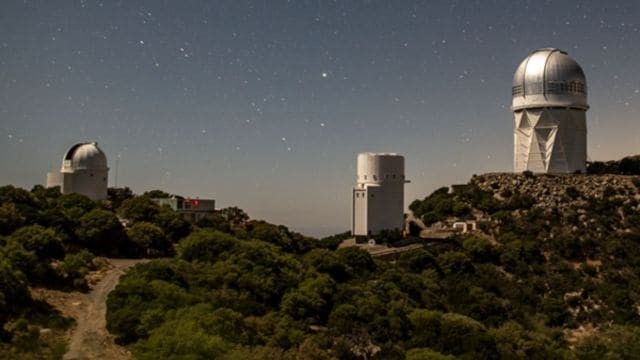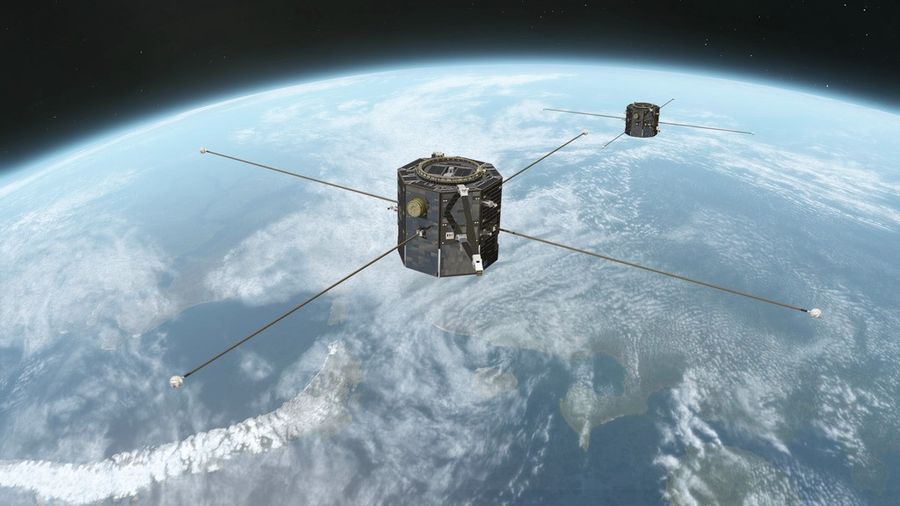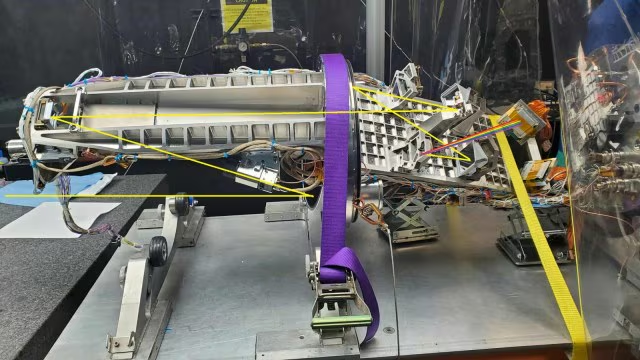Description

Source: Indian Express
Disclaimer: Copyright infringement not intended.
Context
- The recent release of a comprehensive three-dimensional map of the universe by an international team of researchers, including a prominent Indian team led by Shadab Alam at the Tata Institute of Fundamental Research in Mumbai, marks a significant milestone in cosmological research.
Details
- This map, derived from the first year of observations by the Dark Energy Spectroscopic Instrument (DESI), offers insights into the spatial distribution of galaxies and holds promise in unraveling the mysteries of dark energy.
Overview of DESI
- DESI, mounted over the Mayall 4-Meter Telescope in Arizona, United States, is a unique instrument capable of capturing light from 5,000 galaxies simultaneously.
- Utilizing DESI, researchers have measured light from six million galaxies, spanning distances of up to 11 billion years ago, to construct the most detailed map of the universe to date.
- This comprehensive map provides precise information about the distances between galaxies, enabling scientists to calculate the expansion rate of the universe and explore the elusive nature of dark energy.
Understanding Dark Energy
- Dark energy, a mysterious force believed to constitute nearly 70% of the universe, has perplexed scientists for decades.
- The hypothesis of dark energy arises from the observed phenomenon of the universe expanding at an accelerating pace, contrary to the gravitational forces that tend to pull celestial objects together.
- Despite extensive research efforts, the nature and properties of dark energy remain elusive, prompting scientists to explore new avenues for understanding its fundamental characteristics.
Insights from DESI
- The DESI collaboration's measurement of the expansion rate of the universe, increasing by 68.5 km per second after every 3.26 million light years of distance, represents a significant scientific milestone.
- By accurately determining the distances between galaxies, DESI provides valuable insights into the behavior of dark energy and its impact on the cosmic expansion.
- While the data from DESI has generated excitement among scientists, further analysis and observation are needed to unlock the full potential of this groundbreaking research.
About Dark Energy
- Dark energy is a hypothetical form of energy that is thought to permeate all of space, causing the universe's expansion to accelerate.
- It acts as an "anti-gravity" force, causing cosmic objects to repel each other and stretch spacetime.
- Discovery: The existence of dark energy was inferred from observations of distant supernovae in the late 1990s.
- Nature: Its exact nature remains unknown, but it's often associated with the cosmological constant or quintessence, a dynamic field.

Historical Context
- Early Universe: Initially, the dominant force was gravity, leading to the deceleration of the universe's expansion.
- Discovery of Expansion: Edwin Hubble's observations in the 1920s provided the first evidence of the universe's expansion.
- Accelerating Expansion: Observations of Type Ia supernovae in the late 1990s revealed that the expansion of the universe is actually accelerating.
- Einstein's introduction of the cosmological constant as a "fudge factor" and its later revival as a component of dark energy demonstrate the evolving understanding of the universe's dynamics.
Evidence for Dark Energy
- Type Ia Supernovae: The dimness of distant supernovae compared to their expected brightness indicates accelerated expansion.
- Cosmic Microwave Background (CMB): Measurements of the CMB also support the existence of dark energy through its effects on the large-scale structure of the universe.
- Baryon Acoustic Oscillations (BAO): These oscillations in the distribution of galaxies provide further evidence for dark energy.
Theoretical Explanations
- Vacuum Energy: Particles popping in and out of existence in empty space could contribute to dark energy.
- Fifth Force: A hypothetical force responsible for negative pressure, causing accelerated expansion.
- Quintessence and Tachyons: Concepts like quintessence, low-energy fields, and tachyons are proposed as explanations for dark energy.
Cosmological Models
- Lambda-CDM Model: The prevailing cosmological model incorporates dark energy as a cosmological constant (Λ) along with cold dark matter (CDM).
- Modified Gravity Theories: Alternative theories seek to explain cosmic acceleration without dark energy by modifying Einstein's theory of General Relativity.
Properties of Dark Energy
- Negative Pressure: Dark energy is associated with negative pressure, causing repulsive gravitational effects.
- Uniformity: Dark energy appears to be uniformly distributed throughout the universe.
- Energy Density: It constitutes about 68% of the universe's total energy density.
Implications
- Future of the Universe: The dominance of dark energy suggests that the universe's expansion will continue indefinitely, leading to the "Big Freeze" scenario.
- Cosmic Structure Formation: Dark energy affects the formation of large-scale structures in the universe.
- Cosmological Constant Problem: The value of the cosmological constant presents a fundamental problem in theoretical physics known as the cosmological constant problem.
Ongoing Research
- Dark Energy Surveys: Ongoing surveys, such as the Dark Energy Survey (DES) and the Large Synoptic Survey Telescope (LSST), aim to further constrain the properties of dark energy.
- Experimental Tests: Continued efforts to test alternative theories of gravity and dark energy through experiments and observations.
- Theoretical Investigations: Further theoretical work to reconcile the properties of dark energy with quantum mechanics and particle physics.
Effects of Dark Energy
- Large-Scale Expansion: Dark energy causes the universe to expand at an accelerating rate.
- Gravitational Bound Objects: Objects like stars, galaxies, and even coffee mugs, which are gravitationally bound, do not experience the effects of dark energy on small scales.
- Galactic Separation: Dark energy acts on the largest scales, causing galaxies to move away from each other over vast distances.
Dark Energy's Impact on Galaxies
- Observable Effects: Galaxies recede from each other due to dark energy's influence, with the rate of separation increasing with distance.
- Measurements: Observations indicate that galaxies are moving apart at significant speeds due to dark energy, such as GN-z11, which recedes faster than the speed of light.
Contrast with Dark Matter
- Different Properties: Dark energy and dark matter are distinct entities with different effects on the universe.
- Gravitational Influence: Dark matter holds galaxies together on smaller scales, counteracting the effects of dark energy.
- Composition Ratio: Dark matter outweighs baryonic matter in the universe by about 6 to 1, while dark energy accounts for a significant portion of the universe's energy and matter budget.
Implications for the Universe's Destiny
- Big Crunch vs. Big Rip: Dark energy's acceleration rules out the possibility of a Big Crunch, leading to scenarios like the Big Rip, where dark energy ultimately dominates over all other forces, tearing apart the fabric of the universe.
About Dark Matter
- Dark matter is a hypothesized form of matter that does not emit, absorb, or reflect electromagnetic radiation, making it invisible and detectable only through its gravitational effects.
- Discovery: The concept of dark matter was proposed in the 1930s by Fritz Zwicky to explain the apparent discrepancy between the observed gravitational effects in galaxies and the visible matter within them.
- Nature: Dark matter is thought to constitute about 27% of the universe's total mass-energy content, making it a significant component of the cosmos.
Properties of Dark Matter
- Invisibility: Dark matter does not interact with electromagnetic forces, including light, making it invisible to conventional telescopes.
- Gravitational Effects: Dark matter exerts gravitational influence, affecting the motion of stars, galaxies, and galaxy clusters.
- Cold Dark Matter: The prevailing theory suggests that dark matter is "cold," meaning its constituent particles move slowly compared to the speed of light.
Evidence for Dark Matter
- Galactic Rotation Curves: Observations of galaxies' rotational velocities imply the presence of unseen mass, which is attributed to dark matter.
- Gravitational Lensing: The bending of light around massive objects, such as galaxy clusters, indicates the presence of unseen mass, consistent with dark matter.
- Cosmic Microwave Background (CMB): Anisotropies in the CMB provide further evidence for dark matter's existence through its gravitational effects on the early universe's density fluctuations.
Candidates for Dark Matter
- Weakly Interacting Massive Particles (WIMPs): WIMPs are hypothetical particles that interact weakly with ordinary matter and are prime candidates for dark matter.
- Axions: Axions are hypothetical particles proposed to solve certain problems in particle physics and are considered potential constituents of dark matter.
- Sterile Neutrinos: Sterile neutrinos, neutrino-like particles with mass, are also considered as candidates for dark matter.
- Primordial Black Holes: Primordial black holes formed in the early universe are another proposed candidate for dark matter.
Cosmological Significance
- Structure Formation: Dark matter plays a crucial role in the formation and evolution of large-scale structures in the universe, such as galaxies and galaxy clusters.
- Cosmic Microwave Background: Dark matter's gravitational effects imprint distinct patterns on the CMB, providing insights into the universe's early history.
- Galactic Dynamics: Dark matter influences the dynamics of galaxies, affecting their shapes, sizes, and interactions with neighboring galaxies.
Experimental and Observational Efforts
- Direct Detection Experiments: Scientists conduct experiments to directly detect dark matter particles interacting with ordinary matter.
- Indirect Detection Methods: Observatories search for signals, such as gamma rays or neutrinos, produced by dark matter annihilation or decay in regions of high dark matter density.
- Collider Experiments: Particle accelerators like the Large Hadron Collider (LHC) aim to produce and study dark matter particles through high-energy collisions.
- Dark Matter Surveys: Ongoing surveys, such as the Dark Energy Survey (DES) and the Large Synoptic Survey Telescope (LSST), aim to map the distribution of dark matter in the universe.

Conclusion
- The DESI three-dimensional map of the universe stands as a testament to the collaborative efforts of researchers worldwide and signifies a significant advancement in cosmological research.
- As scientists delve deeper into the data and analyze the intricacies of the cosmic landscape, DESI holds the promise of unlocking the secrets of dark energy and illuminating our understanding of the universe's origin, evolution, and ultimate fate.
Sources:
Indian Express
Space
|
PRACTICE QUESTION
Q. Dark energy remains one of the most profound mysteries in modern cosmology, challenging our understanding of the fundamental forces and constituents of the universe. Comment. (150 Words)
|











